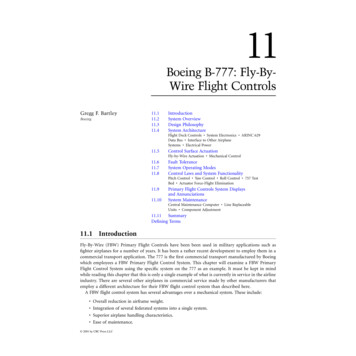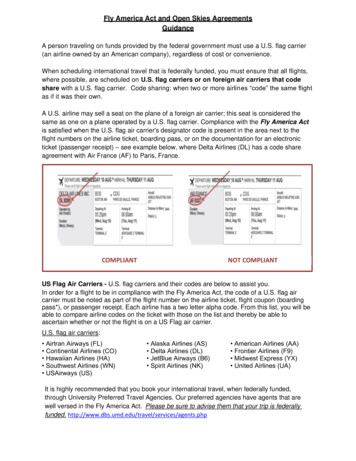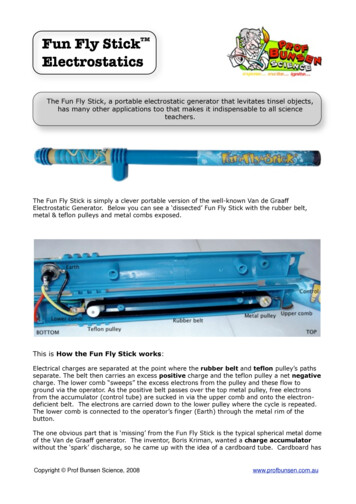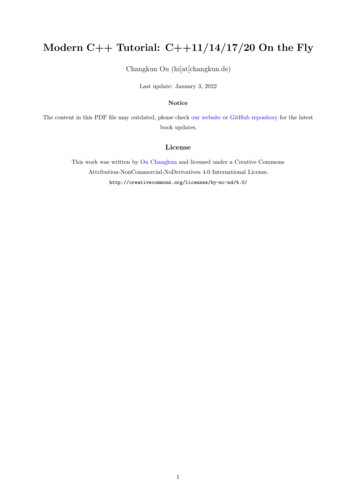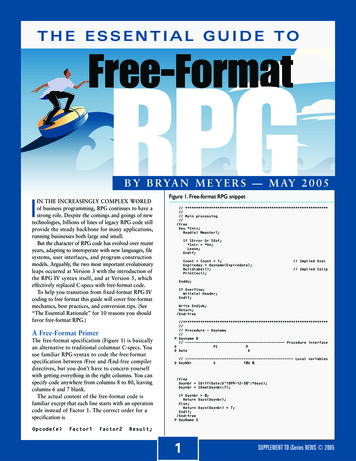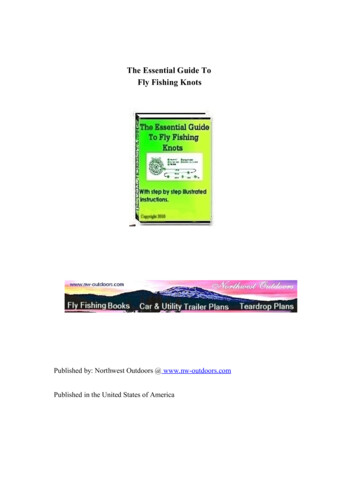
Transcription
The Essential Guide ToFly Fishing KnotsPublished by: Northwest Outdoors @ www.nw-outdoors.comPublished in the United States of America
The Essential Guide ToFly Fishing KnotsEssential Guide To Fly Fishing Knots by Northwest Outdoors is licensed under aCreative Commons Attribution-NonCommercial-NoDerivs 3.0 Unported License.Based on a work at www.nw-outdoors.comThe redistribution terms of these materials must comply with the following criteria:1. Free Redistribution1a The redisdributiion shall not restrict any party from giving away these works.1b The distribution shall not require a royalty or other fee such as the selling of these works.1c These works must be made available for downloading via the Internet without charge.2. No Modifications2a These works must be given away without any editing or modifications to any of the content.2b The content, links, and ads must not be edited or modified.2c These redistribution terms must remain within the work and shall not be edited or modified in any way.
You can find more free fishing ebooks on our free downloads page.No sign up or email needed. Just download your ebook. Go ou can also check out some of the quality ebooks we sell by top authors on ourFly Fishing eBooks Catalog page at Visit www.nw-outdoors.com for the best prices on fly fishing ebooks,books and other fly fishing products!
This guide to fly fishing knots contains illustrated instructions to essential and othercommonly used knots in fly fishing as well as a description of what each knot is used for.If you don't want to learn all of them, I recommend learning the first 6 knots, you really shouldn't haveany need for any more than those, but we included others just in case you might want to know how to tiethose as well.Fly Fisher's KnotsA few knots have become more or less standard for attaching the various parts of the flylines and backing, etc, together. Some of the knots that are known by most every fly anglerare:# 1. The Improved Clinch Knot which is commonly used to attach the fly to the leader.# 2. The overhand slip knot or Arbor Knot which is used to attach the backing to the spool.# 3. The Albright Knot which can be used to attach the fly line to the backing.# 4. The Nail Knot which is used to attach the leader to the Fly Line.# 5. A loop can then be tied at the end of this mono filament butt length using a DoubleSurgeon's Knot# 6. A Perfection Loop, may in turn be connected via a loop to loop connection. The useof loop to loop connections between the fly line and the leader provides a quick andconvenient way to change or replace a tapered leader.
Knots:# 1. Improved Clinch KnotA well known and easy knot to tie.This knot is used to tie flies to the leader or tippet.Step 1: Feed the leader/tippet through the eye of the hook.Step 2: Wrap the tag end around the running line approximately 6 times.Step 3: Bring the tag end back through the area between the eye of the hook and the firstwrap.Step 4: Take the tag end and place it back through the area between all the wraps and the line.
Step 5: Lubricate with saliva or water, pull tight, and trim close.
# 2. The Arbor KnotThe Arbor Knot is used as the basic connection for anchoring backing to the reel arbor orspool center.Tie an overhand knot on the backing end and tighten it. Insert this knotted end between thereel foot and the arbor, circle the arbor, and pull the knotted end out so it's next to thestanding part of the backing. Tie a second overhand knot with the tag end around thestanding part of the backing.Holding the reel in your left hand, pull on the standing part of the backing with your righthand, snugging the knots against the arbor. Trip the tag end, and wind the backing onto yourreel. Make sure the line feeds from the guide on the rod to the bottom of the reel. If not,you're winding in the wrong direction.Make tight, smooth layers across the arbor as you wind on the proper amount of backing.The next step is attaching the line to the backing and winding it onto the spool. This is doneusing the Albright Knot.# 3. Albright KnotUsed for connecting your fly line to your backing. This knot slides through your guides wellwhen a fish takes you into your backing.Start by unwinding 2-3 feet of fly line from the plastic spool it came on, unwind the endmarked ""this end to reel".Step 1. To use the Albright Knot for tying backing to fly line, you start by doubling back acouple of inches of fly line and hold the loop with your left thumb and forefinger.Step 2. From the right, insert about 10 inches of the backing through the fly line loop. Whileholding the loop, pinch the backing between your left thumb and forefinger, and use your
right hand to wrap the backing tag end back over both strands of the fly line and thebacking.Step 3. Start next to your fingers and working toward the loop end, make 1 0 to 12 fairlytight wraps. Push the tag end of the backing back through the loop on the side oppositewhere it originally entered so both backing strands exit on the same side of the loop. Pull onthe standing part of the backing to remove the loop you where holding in your left hand.Step 4. Pull both ends of the fly line backing. Pull gently on both ends of the fly line loopwith your left hand; squeeze the knot with the fingers of your right hand and work it down tothe loop end, but not off the fly line. Moisten the knot. Hold the standing and tag fly linestrands in your left hand, and the tag and standing backing strands in your right hand. Pull astight as possible. Clip off the tag end of the fly line and the backing.# 4. Nail KnotUsed for leader to Fly Line.The Nail Knot requires a small diameter tube, such as the barrel of a ballpoint pen, a nailknot toot or other similar object about twice the diameter of the fly line. Using a smalldiameter tube makes the knot easier to tie.
Step 1. Hold the tube and the end of the fly line with your left thumb and forefinger soabout two inches of the fly line and the tube sticks out to the right. With your right hand,form a 2" loop in the heavier end of your leader. Pinch down and hold this loop with yourleft thumb and forefinger next to the tube and fly line.Step 2. Use your right hand to grasp the short leg of the leader loop and make 5 snug wrapsover the tube and fly line. These wraps should butt against each other, and be at least 1/2" to3/4" from the end of the fly line. Then slide your left thumb and forefinger forward to holdthe wraps so they don't unwind while you work the tag end of the leader butt through thetube from right to left.Step 3. Carefully remove the tube by sliding it to the left. Semi-tighten the knot by pullinggently on both ends of the leader. Don't pull on the fly line. Moisten the knot area, inspectthe knot wraps for smoothness, and tighten the knot by simultaneously pulling on both endsof the leader so it "bites" into the fly line.Step 4. Then pull hard on the fly line and leader to "seat" the knot. Finally trim the leader tagend and the fly line end.# 5. Double Surgeon's KnotThe Double Surgeon's Knot is a great knot for attaching your tippet to you leader.Clip back a small section of the pre-made leader tip and then tie in your own tippet based on
the size fly you will be presenting. This way as you attach new flies to your tippet whenchanging them on the stream, you can simply tie on a new tippet to the leader when it gets toshort. That way you won't be reducing the effective length or design of the pre-made leaderevery time you tie on a new fly.Step 1 The Double Surgeon's Knot requires the leader and tippet to be placed side-by-sideso they overlap (for about 6") with ends facing in opposite directions.Step 2 - Pinch the standing leader and tippet tag end with the left thumb and forefinger anduse the right hand to tie an overhand knot with the leader tag end and the tippet.Step 3 -The entire length of the tippet must be passed completely through the overhand knotloop; even tough the leader tag end is only about 5" long. Don't tighten the completedoverhand knot!Step 4 - Grasp the completed loop with the left hand and make another pass through thesame overhand knot, passing the full length of the tippet and the leader tag end through asecond time.Draw the loop down by simultaneously pulling on leader and tippet. Moisten the loop; graspthe leader and tippet tag on the left with your left hand, and the tippet and leader tag on theright with your right hand. Pull all four ends simultaneously to snug the knot tight. Trim tagends.# 6. Perfection Loop
The Perfection Loop loop to loop method of attaching a tapered leader to the fly line.Step 1: Make a loop to the rear of the line. The end of the line should be going to the tier’sright. Make sure you leave yourself some extra line.Step 2: Take the tag end and wrap it around the base of the first loop. This will create aloop in front of the first loop. Be sure to hold both loops together.Step 3: Take the tag end of the line and place it between the two loops and hold it all down.The end of the line will be pointing to the tier’s left.Step 4: Reach behind the first loop and grab the second loop (the one closer to you) frombehind and pull it through.*It is important to make sure that the tag end of the line dose notslip out.
Step 5: Lubricate the knot with saliva or water, tighten, and trim the excess.Leader Knots - Mono To Mono & Mono To Fly LineBlood KnotA knot used to tie two mono filaments together, i.e. tippet to leader or two pieces of aknotted leader. The knot is a bit difficult to tie, but can be tied without tools with somepractise. It is compact and has a high breaking strength and leaves the line absolutelystraight.The number of turns can be varied, but 3-5 turns work well on most lines. Cut the tag endsvery close to the knot.
Surgeon's knotThis knot is normally used to tie two mono filaments together, i.e. tippet to leader. The knotis fast and easy to tie and has a high breaking strength. It does require one side to passthrough the loop and is more bulky than the Blood knot. It also leaves a small angle on theline. The number of turns can be varied, but two turns work best on most lines.Leader Knots - Mono To Fly LineNeedle KnotAn excellent knot for attaching the leader to the fly line. It yields a very neat, straight andstrong transition between the mono filament leader and coated fly line. It requires that youpass the mono through the core of the fly line by poking a hole with a needle.Cut the leader at an angle with a pair of scissors to make this process easier. Pull 10
centimeters or 4 inches of leader butt through core and out through a hole in the side of thefly line coating and tie the knot.Nailess KnotAn fine knot for field attachment of a leader to the fly line. It is almost as straight and strongas the above needle knot, but can fail if the coating is pulled off the fly line core.The advantage is that it does not require tools other than a line clipper. Lay the butt of theleader along the fly line with about 10 centimeters or 4 inches overlapping.Fold 3/4 of the tag end of the butt back towards the end of the fly line and fold it over andaround the whole assembly in 4-6 tight loops close to the end of the fly line, working yourway back towards the loop formed by the mono.Hold the loops tightly between your fingers. Pass the mono tag through the loop andmoisten the whole knot before tightening the mono. Work the knot slowly together arrangingthe loops nicely. Tighten by pulling both ends of the mono. Do not pull the fly line beforethe knot is very tight! Trim both lines as close to the knot as possible and test with a firmpull on the fly line and leader.Trilene KnotThe breaking strength is very high for this knot; very close to 100% for some lines anddiameters and almost always above 90%. Do not cut the tag end too close. The knot has atendency to untie itself after many casts.
Fly Attachment KnotsPalomar KnotA knot that is easy to tie and has a good breaking strength of over 90%. It can be difficultpassing the line twice through the hook eye, but pass the tag end though one way first andthen back. Then make the loop as small as possible and pass it over the hook. Tighten byfirst pulling both ends - then the tag end alone.Duncan LoopThe classical loop for flies that need to work freely on the tippet. Fairly easy to tie and canbe tightened according to taste.Orvis Knot
Can form a loop that tightens when under strain. Its strength almost compares to the Trileneknot with a 95% average.Figure 8 loopAn easy-to-tie loop that leaves the line and eye in a straight line. It is a bit difficult to tightenin a manner that results in a small loop. A too large loop will often catch the fly or somematerial and leave the fly fishing sideways or backwards.The figure 8 loop is also great for making loops on leader butts and tips and good to use ontippets if you want a loop-to-loop connection between tippet and leader.A Few Things To Remember.* Always tie the knots exactly as shown.* Pass the lines the same way around each other as shown.* Use as many twists, passes etc. as shown. The number may vary with line thickness.* Always moisten the knot before tightening. Knots tightened dry have down to half thebreaking strength.* Tighten as described -- mostly with an even firm pull, but sometimes with a jerk or onespecific end first.
Leader Knots - Mono To Mono And Mono To Fly LineLeader Knots - Mono To MonoBlood KnotThe blood knot is a knot used for attaching two pieces of monofilamenttogether, primarily for rebuilding tapered leaders. This is an extremelystrong knot when formed properly and should be tied with monofilamentclose in diameter. Best use is for monofilament 10 lbs. and up.See illustration below instructions.Step 1. Lay both sections of monofilament across one another. Wrap onesection 5-6 times around the other bringing the end back down through theloop formed by both.Step 2. Wrap the other line 5-6 times around the remaining portion of thefirst line and pass it's free end up through the formed loop.Step 3. Moisten the knot with your mouth, and while holding the long endspull the knot tight. Clip the short ends close and the knot is complete.
Surgeon's knotThe Surgeon's Knot is a knot also used for attaching two pieces ofmonofilament together. It is a very fast and easy knot to tie and is usuallypreferred more than the blood knot. This is a great knot for joining twopieces of monofilament that are greatly different in diameter.When you are building a tapered leader, tied correctly, this knot is generallystronger than the blood knot. Very quick and easy knot for attaching4X-5X-6X-7X tippet to each other. You can do this one in the dark.See illustration below instructions.Step 1. The main line should come in from the left and the line to be attachedshould come from the right. Overlap the two pieces approximately6 or so inches.Step 2. Pinch the overlapped lines together on the left between your thumband index finger. Do the same with the sections on the right and make aloop by crossing it over itself. Take the long and short lines that are in yourright hand and pass them through the formed loop. around, and backthrough a second time.Step 3. Pull both pieces being held in each hand away from each otherclosing the knot. Moisten and pull tight. Once this not is secure you cantighten it further by pulling individual pieces. I would not recommend thisknot for line over 30lbs because it will be hard to tighten and the strength ofthe knot will only be there if tightened all the way.
Leader Knots - Mono To Fly LineNeedle KnotTricky to master at first, this is by far the best leader attachment knot of all.With practice, you can tie one in less than two minutes, and it will last aseason or two.1. Prepare the leader butt by cutting it at a slant to make a point. Insert aneedle into the end of the fly line and out of the side, as shown. (Rotatingthe needle to eases its passage through the fly line core.)2. Keep the fly line folded back as you withdraw the needle and insert theleader but, threading 20 cm (8 inches) out of the side of the line.3. Wrap four or five turns loosely around the fly line. Fold the end of theleader back to create loop A. Fold the leader a second time to create loopB.
4. Hold loop B alongside the end of the fly line where the final knot is to be,and now unwind the five turns, covering loop B with each turn. Whilepreventing the turns from uncoiling, pull on both free ends of the nylon.5. Finally, push turns closely together, tighten fully and trim off the looseend of leader butt.Nail-less Nail KnotA fine knot for field attachment of a leader to the fly line. It is almost asstraight and strong as the above needle knot, but can fail if the coating ispulled off the fly line core.Step 1Hold your fly line (black) and create a loop as shown with your leader.Hold at point: A
Step 2Thread the leader up and through the loop about 5 times.Step 3This is the tricky part, hold both ends of your leader as you gently pull theknot up tight. It's easy to let the knot slip off the end of your line at thispoint. Pull up very tight and then test the knot to see that it doesn't pull offthe end of the fly line. Trim the knot ends close so they don't catch in yourrod guides.Trilene KnotThe Trilene Knot is a strong knot that can be used to join line to swivels,snaps, hooks and lures. The breaking strength is very high for this knot;very close to 100% for some lines and diameters and almost always above90%. Do not cut the tag end too close.Thread the line through the eye of the hook or lure and double backthrough the eye a second time.1. Holding the hook or lure in your left hand, and the standing line in yourright hand, loop the tag end around the standing line 6 times. Then feed thetag end through the loop made in step 1.2. Tighten the knot by pulling gently on the tag end and the standing linesimultaneously. Moisten the knot with water as you tighten to lubricate theline, allowing the knot to slide more easily while tightening. Trim tag end to1/8 inch.3. Tying the Trilene Knot is complete.
Fly Attachment KnotsPalomar KnotA knot that is easy to tie and has a good breaking strength of over 90%.Duncan LoopAlso known as the Uni-KnotUsed to Tie fly to tippet. Creates a sliding loop that can be left open ortightened against hook eye. The open loop on this knot lets nymphs andother subsurface flies “swim” in the water and bass bugs pop better.Step 1:Pass 6? to 8? of tag end of tippet through the eye of hook. Form a 1.5?diameter loop with tag end.
Step 2:Pass tag through and around loop and tippet five times, moving away fromfly.Step 3:Lubricate and tighten knot by pulling very tightly on tag end. The degree oftightening determines how knot slides on tippet for keeping loop open orsliding it closed. With heavy tippet materials (over.011?), grasp the tag endwith pliers or hemostats and tighten the knot.
Step 4:Adjust loop between fly and knot as desired. Trim tag end.A Few Things To Remember.* Always tie the knots exactly as shown.* Pass the lines the same way around each other as shown.* Use as many twists, passes etc. as shown. The number may vary with line thickness.* Always moisten the knot before tightening. Knots tightened dry have down to half thebreaking strength.* Tighten as described -- mostly with an even firm pull, but sometimes with a jerk or onespecific end first.
* Pull tag ends first unless otherwise indicated.* Use the correct knot for the purpose intended.* When joining lines note weather the lines are the same or different diameters. If there istoo big a difference use a different knot.* Choose a few reliable knots that work well for you and use those for most of your knots.* Inspect knots for looks and test all knots with a firm pull before using.* Practice Tying Your Knots!!!!!!* Find A Few Knots That You Are Good At And Stick To Those For The Most Partwhenever possible.*Practice, Practice, Practice!!!!!
A special thanks to Brian J. Norris for the use of the information contained in this guidefrom his book “Flies, Lures, Knots And Tying The Fly”.If you are interested in learning Fly Tying and all about Artificial Flies, I highly recommend"Flies, Lures, Knots And Tying The Fly"You can get find it at the lowest price on the netby visiting: www.nw-outdoors.comAll contents of this work is protected by copyright and may not be edited, modified orcopied.This ebook may be freely re-distributed.
Books Of InterestAt:www.nw-outdoors.com
Knots: # 1. Improved Clinch Knot A well known and easy knot to tie. This knot is used to tie flies to the leader or tippet. Step 1: Feed the leader/tippet through the eye of the hook. Step 2: Wrap the tag end around the running line approximately 6 times. Step 3: Bring the tag end back through
